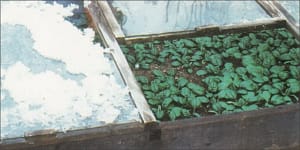The Ultimate Guide to Garden Planning

It’s that time of year again: garden planning season! If you’re looking for the best tips, tricks, and inspiration for planning your garden, you’re in the right place. From using lowers for pest control to permanent beds to choosing a site, we’ve got the reads you need!

It’s difficult to know what flowers are best for your garden. Some flowers, like Dandelions and Sunflowers, are incredibly easy, as long as you have plenty of sunlight. While other flowers, like marigolds, have so many different variations that are each easy to grow in their own right. Grow banks of these flowers around your garden to ensure that predatory insects don’t have to travel far to find food.
Permanent beds are going to change your gardening game. Jesse Frost, author of The Living Soil Handbook, walks you through the process of creating the most efficient garden by looking at the bed width and length, the path width, and the bed orientation. Soon, you’ll have more crops sprouting out of your new permanent beds!
Growing your own food is hard work, but with a few easy tips you can make it a lot easier. Just ask Carol Deppe, author and gardener extraordinaire. Carol grows almost all of the food she eats, but with a cranky back and complaining knees she has been forced to figure out labor-saving techniques and tricks to help make her garden a success.
There are a lot of things to take into consideration when starting a garden: When to plant, where to plant, how to plant, and so on. In order to answer these questions, you first have to answer a much broader one: “How can I work with nature to make this garden regenerative and sustainable.” If we let go of the power we have (or think we have) over nature and instead work with it, our gardens turn out so much better. The first step in this process? Asking questions about your environment to properly design your garden.
Starting plants from seed does not have to be difficult or time-consuming. Sure, it will take you a season or two to get the hang of it, but after that, the process will feel simple. To get started, you’ll need a space indoors that has natural light from a window, or else a tabletop area above which you can mount a fluorescent light. Or, if you want to start seeds outdoors with climate protection, you could use a grow-frame, plastic cover, or small hobby greenhouse. Either way, you’ll be ready to start your seeds in no time!
We may be in the dead of winter today, but spring is just around the corner! Which makes now the perfect time to start planning out your garden. If you’re new to gardening or homesteading, the location of your new garden is one of the first things to consider.
What exactly should you be looking for in a location? Follow this handy list and set yourself up for a successful growing season.
Recommended Read
Recent Articles
So you want to start reaping your harvest, but you’re not sure where to start? Learn how to break down the options of harvesting tools!
Read MoreWant to start your own medicinal herb garden? Passionflower, lemon balm, and goldenseal are great places to begin! These herbs are jam-packed with medicinal properties and easy to grow in a majority of climates.
Read MoreDoes the cold weather have you dreaming about fresh greens and colorful salad? Grow and harvest sprouts indoors to make those dreams a reality! Follow this quick start guide to year-round greens for fresh salad greens in just a couple of weeks! The following is an excerpt from Year-Round Indoor Salad Gardening by Peter Burke. It…
Read MoreAre you ready to get a jump-start on the gardening season? With a cold frame, you can get started now. A cold frame harnesses the sun’s heat before it’s warm enough to let unprotected seedlings growing outside. Essentially, it consists of a garden bed surrounded by an angled frame and covered with a pane of…
Read MoreSprouts are easy to cultivate, mature quickly and pack a nutritional punch! You can make nutrient-rich sprouts from all kinds of edible seeds in your kitchen.
Read More












